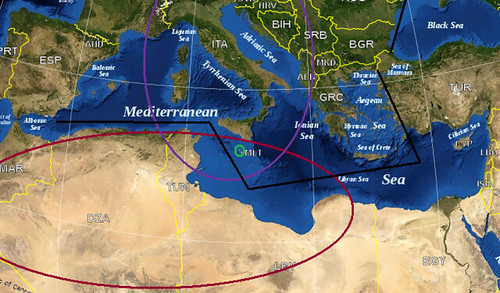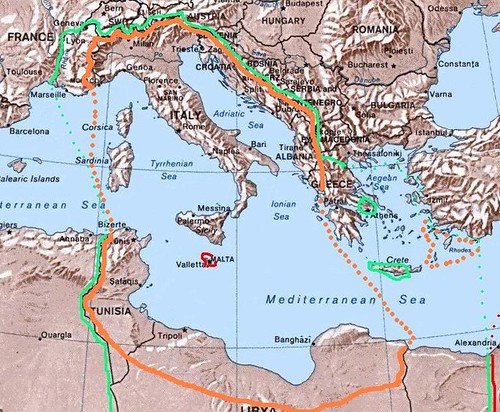Italy has declared a state of emergency on the southern island of Lampedusa and appealed to the rest of the EU for help following the arrival of up to 5,000 people fleeing the political upheaval in Tunisia.
Silvio Berlusconi's foreign minister, Franco Frattini, said he had contacted Catherine Ashton, the European Union's high representative for foreign affairs, to propose a blockade of Tunisian ports by the EU's Frontex agency which could "mobilise patrols and refoulement [the forcible return of would-be migrants to their country of departure]".
He said a similar exercise was carried out by Italy when 15,000 Albanians arrived in 1991. "I hope the Tunisian authorities accept the Albanian model," Frattini said in an interview with the Corriere della Sera newspaper.
The Albanian model? Frattini's comparison made a certain amount of sense, in that migration from Albania to Italy only began after the collapse of Communism in Albania let Albanians leave their impoverished for work. Frattini might be imagining that Tunisia without Ben Ali would trigger similar migration. If so, his comparison is off-base: the collapse of Communism in Albania led directly to the collapse of the Albanian economy and border controls, creating the incentive and the means for Albanians to leave their country, while the end of the Ben Ali regime in Tunisia coincided with harder times, yes, but not with an economic collapse comparable to post-Communist Albania's.
After I blogged here about Malta last month, I made a tie-in post at another group blog, History and Futility. Malta's current status as a democratic European nation-state embedded in the European Union is grounded on a particular interpretation of Maltese cultural and geographic realities. Other interpretations are possible.

The small light green circle surrounding the archiepelago reflects Malta’s identity as small and unique, isolated in the Mediterranean on its small land base and with its unique culture; the large purple circle to denote Malta’s location within a sort of Italian sphere of influence, more vestigial than before, thankfully, when Italy lay claim to Malta (and the other territories within the circle) as rightfully Italian regardless of local opinion; red denotes Malta’s links with North Africa, low key and unemphasized but real as evidenced by the Semitic Maltese language and the apparent popularity of post-independence Malta’s flirtations with a radically anti-colonial Libya; black, to show Malta’s location within the European Union, its hoped-for final destination. Different people can agree that Malta is located at 35°53′N 14°30′E and disagree on the relative importance of the different human factors–language, religion, migration, history, trade, politics–which assign meaning to those geographic coordinates.
Much the same sort of thing can be said about Italy, which had its own maps, its own perceptions of its neighbourhood. These perceptions were more aggressive by far than anything of the Maltese, granted.

I copied this map of Italian territorial claims under fascism from the Wikimedia Commons. As described by the creator brunoambrosio, it is a map of "the 1940 project "Greater Italia", inside the orange line and dots, in Europe and North Africa. Self-made (I have based my work on the original Commons Image:Mediterranean Relief.jpg, licensed PD-USGov). The green line and dots show the biggest extension of Italian control in the Mediterranean sea in november 1942 (while the red shows the British controlled areas, like Malta)."
Albania, source of modern immigrants to Italy, was firmly in the Italian sphere; Tunisia, then (under French protectorate) not a source of immigrants but rather as a target for irredentist sentiment and in many ways an Italian settlement colony, was included briefly; Libya, the "Fourth Shore" of Fascist Italy and core of the Fascist Roman Empire, was Italian for thirty years. Ethiopia, Eritrea, and Somalia are not shown here.
James Miller noted that for most of its history Italy was caught by the image of the Mediterranean as a forum for expansive imperialism, as a place where Italy could show off its emergent great power status and underline its modernity.
Students of literature often construct their understanding of a topic primarily from books and readings. But that’s not the case for students in Giuliana Minghelli’s new [Harvard] course on cultural migrations between Africa and Italy, where they have witnessed a performance by one of the assigned authors and have the opportunity to develop their own creative responses.
Minghelli, associate professor of Romance languages and literatures, found her interest in the subject piqued by her study of Italy’s early 20th century modernist writers. Many of them, she discovered, were either born in or had lived in Africa.
“People like Futurism founder Filippo Tommaso Marinetti chose Africa as the stage on which to perform the speed, modernity, action, and violence of his Futurist poetics,” Minghelli noted. “That is quite intriguing. Why Africa?”
On the one hand, she said, Africa represented a blank canvas onto which Italian writers could project their wildest fantasies. At the same time, the continent functioned as a land of exile and escape, initially from the fascist regime that controlled Italy in the decades leading up to World War II.
Later, in the 1960s, writers fled from the homogenization of capitalist consumer culture. For instance, author and film director Pier Paolo Pasolini traveled to Africa in search of an alternative, uncontaminated world.
Indeed, despite a desire on the part of many Italian authors to paint Africa as a primitive and exotic world, the continent is very close to Italy, perhaps uncomfortably so for many at the time. After the unification of Italy in 1861, Italians strove to present themselves as a thoroughly European culture, repressing what Minghelli calls “the Africa within Italy.”
Yet Italy also needed Africa, for economic reasons and because it was felt practicing colonialism would establish a stronger sense of national identity. The Italians were late to the “scramble for Africa,” waiting until 1936 — after the conquest of Eritrea, Somalia, and Ethiopia — to proclaim an official Italian Empire. The desire for conquest was buoyed by archaeological excavations in Africa that unearthed Roman ruins, which Italians used to link their colonizing activities to the glory of the Roman Empire.
“If you’re interested in the question of Italian nation-building and identity formation, Africa is really central,” Minghelli said.
The post-colonial element in Italy's relationship to once-subordinate and migrant-receiving, now independent and migrant-sending, countries on its frontiers is something that doesn't seem to have been investigated that much, notwithstanding the origins of many of these unpopular immigrants in former Italian colonial or near-colonial countries (Tunisia, Eritrea, Somalia, Ethiopia) and the importance of post-Italian Libya as a corridor. It played a role: see how Italian links encouraged a relatively much greater volume of post-colonial immigration to Italy from Eritrea as opposed to Somalia. Where else does it play a role, though? What networks have been established? What attitudes are there in Italy towards migrants from ex-Italian colonies: empathy, dislike?




2 comments:
Excellent article. I've always thought of this.
Does the modern migration to Italy follow on from the countries of the former Italian Empire (including Albania) and how are these people treated in Italy? Is there a kind of understanding and maybe greater appreciation of people from these countries in the same way that residents of the UK would somehow be familiar with people from the West Indies or Indian Sub Continent?
I remember being on an over night train from Milan and a young man from Somalia was on it. He spoke fluent Italian as the university courses were still in Italian (this was in 1991). Would that still be the case?
I know Italy lobbied for Eritrea to make Italian the official language when that country gained independence from Ethiopia in the 1990s. Do people there still speak Italian? Is Italian held in high regard? Do people learn Italian as it offers them an escape from Eritrea (or Somalia or Libya)? One can imagine that Italian culture (cafes, football, formula one cars, popular culture and cuisine) would be very appealing - they are to West Europeans too!
Cymro
From what I know, immigration to Italy is substantially not post-colonial. Moroccan immigrants are much more numerous than Tunisian and Libyan combined, for instance, while immigrants from the Middle East and Asia come from countries with trivial, if any, historical connections to Italy.
From what I can tell, Italians don't distinguish significantly between (say) Romance-speaking Romanians, Albanians, and Tunisians and Pakistanis, Ukrainians, and Chinese. A recent Human Rights Watch report suggests all are subject to a common xenophobia.
As for the former Italian empire, so far as I can gather the connections have dried up. The empire was too brief to leave much of a cultural legacy, although Eritrea seems to be a partial exception.
Post a Comment